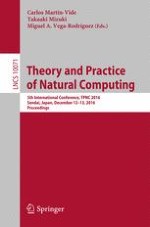2016 | Buch
Theory and Practice of Natural Computing
5th International Conference, TPNC 2016, Sendai, Japan, December 12-13, 2016, Proceedings
herausgegeben von: Carlos Martín-Vide, Takaaki Mizuki, Miguel A. Vega-Rodríguez
Verlag: Springer International Publishing
Buchreihe : Lecture Notes in Computer Science
